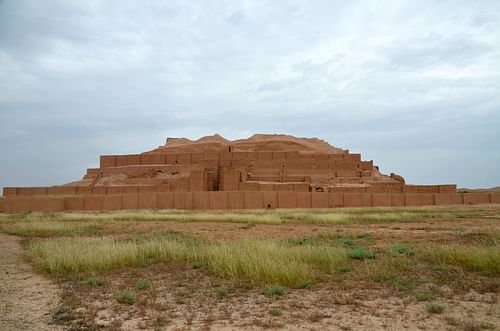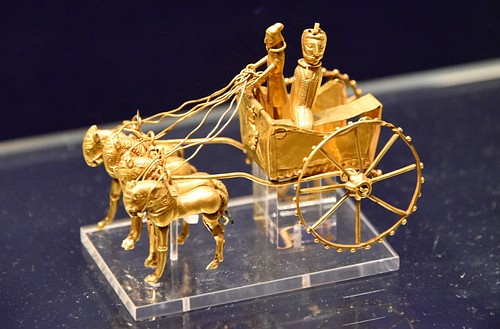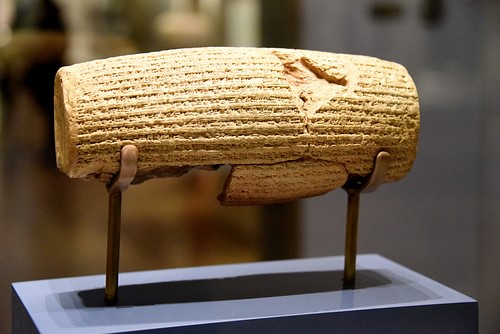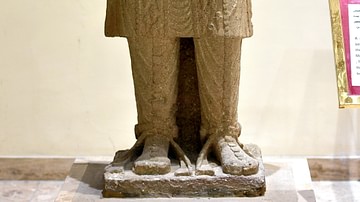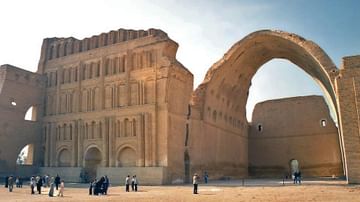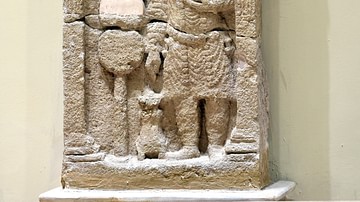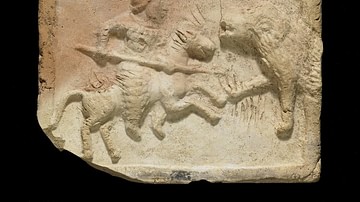
Persian art and architecture in the present day is associated with the nation of Iran and usually designated as beginning with the Achaemenid Empire (c. 550-330 BCE) but has an even longer history with its origins dating back to before the Persians arrived on the Iranian Plateau sometime in the 3rd millennium BCE.
Even so, Persian art and architecture is usually dated to between c. 550 BCE and 651 CE, the beginning of the Achaemenid Empire to the end of the Sassanian Empire. It was influenced early on by the older civilizations of Elam and Susiana in the region and by neighboring Mesopotamia. Early Elamite artworks focused on depictions of animals and the use of geometric and imaginative designs and the art of Susa mirrored this paradigm but expanded upon it through the representations of dogs.
Dogs, in fact, seem to have been among the most popular artistic representations of Susiana. Monumental architecture of this period is best exemplified in the site of Chogha Zanbil (earlier known as Dur Untash) with its towering ziggurat and walls and more modest structures which exhibit the same care in design and construction; these same techniques and designs, minus the ziggurat, would later influence Persian works.
In c. 550 BCE, Cyrus the Great (r. c. 550-530 BCE) founded the Achaemenid Empire whose artistic works drew on the models of the past and improved upon them. The best example of Achaemenid art and architecture are the ruins and works found at Persepolis, the capital city planned and begun by Darius I (r. 522-486 BCE) and largely completed by his son Xerxes I (r. 486-465 BCE). Earlier Elamite structures – such as Chogha Zanbil – had been built of mud brick, but the Achaemenids worked primarily in stone with ornate bas-reliefs as decoration. Achaemenid jewelry was fashioned of precious metals – often gold – and gemstones, exhibiting an impressive level of craftsmanship.
Persian artistic momentum flagged during the time of the Seleucid Empire (312-63 BCE) but was revived during the Parthian Empire (247 BCE - 224 CE) and reached its peak under the Sassanians (224-651 CE) whose empire drew upon the vast history of its predecessors to create some of the greatest monuments and works of art of the ancient world. After the fall of the Sassanian Empire to the Islamic Arabs in 651 CE, Persian artistic innovations continued to influence the art and architecture of the Islamic world and, today, many of these are synonymous with the concept of Islamic Art.
Early Works of Elam & Susiana
For some few thousand years prior to the 3rd millennium BCE, the region of Susiana was inhabited by nomadic and semi-nomadic peoples who eventually settled and founded the city of Susa around 4395 BCE. The Elamites were already in the region at this time, their settlement at Chogha Bonut dating to c. 7200 BCE. These peoples' lives on the Iranian Plateau were alternately influenced by the Sumerians of Mesopotamia and the tribes of the highlands of the Zagros mountains. Scholar Pierre Amiet notes:
when the people of the mountains and the plateau achieved unity in the third millennium BCE, they were able to incorporate Susiana – with its highly developed urban civilization – into a powerful state, the first cultural and political entity recorded in the history of Iran: Elam. (Harper, 2)
By this time, a type of art had already developed in the region which is now known as Proto-Elamite and focused chiefly on depictions of animals. Amiet notes, “Animals were often substituted for people, sometimes in apparently humorous scenes that perhaps evoked fables” (Harper, 3-4). By 5500 BCE, depictions of dogs were prevalent on ceramic vessels from sites in Khuzistan such as Chogha Mish and the site of Tepe Sabz in Deh Luran. The largest collection of dog-ornamented ceramics has come from Susa which suggests a continuation of the Proto-Elamite preoccupation with representations of animals in art.
The Proto-Elamite Period ended with encroachments from Mesopotamia during their Early Dynastic Period (2900-2334 BCE) and, especially, during the Dynastic III Period (2600-2334 BCE) when Sumerian kings like Eannatum (r. c. 2500-2400 BCE) conquered Elam. Mesopotamian influence at this time is evident in statuary representing human figures, most notably statuettes of worshippers placed in sanctuaries to represent the spirit of communal devotion.
The Akkadian Empire took the region under Sargon of Akkad (r. 2334-2279 BCE) further advancing Mesopotamian motifs in the art of the region and, in architecture, this influence was manifest most clearly in the great building complex of Chogha Zanbil, built during the reign of Untash-Napirisha (r. c. 1340 BCE).
Chogha Zanbil is a Mesopotamian ziggurat surrounded by temples and encircled by a wall. Made of baked clay bricks, and inscribed with Elamite phrases, praises, and curses, the complex – located 19 miles (30 kilometers) southeast of Susa – was an attempt to unify the disparate regions of Elam in worship of the god Inshushinak, patron deity of Susa. Although certainly Elamite in character, Chogha Zanbil drew on Mesopotamian motifs and methods of construction which would be developed later in Persian art and architecture. The influence of earlier Akkadian and Sumerian cylinder seals is also evident in the artworks of Elam earlier than Chogha Zanbil - c. 2200 BCE - which depict assorted deities and human figures in communal scenes and these motifs would later be developed by the Persians.
Although the Persians had arrived by the 3rd millennium BCE, they were firmly settled by the 1st at Fars (Pars) close to Elam, the area which would give them their name. When Cyrus the Great founded the Achaemenid Empire in c. 550 BCE, he drew on the long-established culture of the past – which, by this time also included Median contributions – to encourage what is now known as Persian art and architecture.
Achaemenid Art & Architecture
The most famous artworks of the Achaemenid Empire come from the collection known as the Oxus Treasure; a hoard of beautifully crafted works discovered c. 1877 CE buried in the north bank of the Oxus River. This collection includes coins, bowls, figurines and statuettes, jewelry, jugs, and plaques of gold. Although the authenticity of a number of these items has been challenged in the past, the scholarly consensus presently is that they are all genuine artifacts from the Achaemenid period, most likely taken from a nearby temple and buried for safety during one of the many turbulent periods of the region.
The intricacy of design and craftsmanship of some of the pieces demonstrates extraordinary skill in metallurgy, most notably in the armlets, statuettes, and a golden model of chariot with horses and figures. Even though this model is unfinished, the detail of the horses' harness, the wheels, and the ornamentation of the chariot itself would have required considerable effort and a high skill set.
In addition to the artifacts from the Oxus collection, many others have been found in the ruins of cities such as Persepolis and Susa and in excavated graves and tombs. These include plates, bowls, drinking vessels, amulets, and weapons among other items. A royal drinking vessel (rhyton) would be quite ornate, often decorated with animal imagery or in the shape of a bull or goat. More common drinking vessels were bowls or shallow plates which seem to have been cast as the floral motif on the bottom of the vessels is uniform on a number of them and is not duplicated inside the vessel itself. It is quite likely these types of bowls and plates were mass-produced for use as well as trade, while jewelry, for the most part, was handmade and possibly commissioned by a specific royal personage.
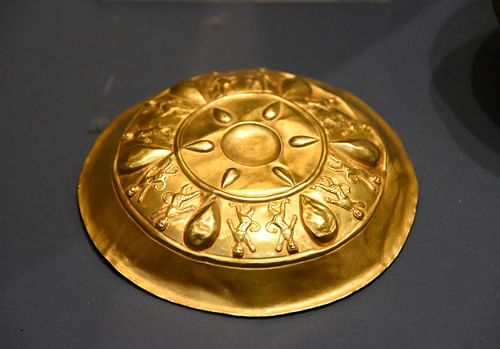
Cyrus the Great was primarily concerned with consolidating his power and expanding his territories – although he no doubt busied himself as well with domestic matters – and his son and successor, Cambyses II (r. 530-522 BCE) followed this same course and so it is not until the reign of Darius I that one finds any real attention paid to artistic and architectural development. Even so, Cyrus devoted considerable time and thought to his capital of Pasargadae, where, according to Pierre Amiet,
He commissioned architecture of a palatial type, intentionally rejecting an urban setting. Two columned halls, which were actually assembly halls for the Persian nobility and not residences, were integrated into a magnificent landscape in a vast, ingeniously arranged, and irrigated garden. (Harper, 13)
Gardens were integral to Persian architecture and featured prominently in design. The Persian word for garden – pairi-daeza – gives English its word paradise because these landscapes were designed so beautifully as to be almost otherworldly. Cyrus is said to have spent as much time as possible in his gardens, most likely to clear his mind before addressing state matters. The gardens were irrigated by the qanat system – sloping channels which brought water up from under the ground – and large plots of flora and fauna were given a prominent place in the central courtyards of palaces and administrative buildings.
Easily the best-known artwork from the Achaemenid Period is the Cyrus Cylinder, a work in clay inscribed with Cyrus the Great's genealogy and vision for his empire. This piece has recently been cited as the first statement in history setting forth a declaration of human rights and guaranteeing freedom of religion and practice for the people of the empire. It should be noted, however, that this interpretation has been challenged.
When Darius I came to power, he rebuilt Susa, adding a palace complex to the site, and followed the same paradigm as Cyrus had in featuring elaborate gardens as central to the design. In his buildings at Susa and Persepolis, Darius I's artisans initiated the motif of the “Persian animal capital” – the figure of a bull or a bird at the top of a column – and also designed these columns as slender pieces which would draw the eye upwards to the capital figure while also accentuating the grandeur of the height of the building. The columns, then, were not just artworks in and of themselves but fully integrated into the overall impression of the structure. Post-and-Beam construction was used for the roof, which – at Persepolis – was made of cedar from the forests of Lebanon.
At Persepolis, Darius I also initiated the practice of ornamentation by bas-relief. The most famous bas-relief at Persepolis shows the many different people of the Achaemenid Empire arriving to pay homage to the Persian emperor, and these images are so detailed that the nationality of each individual is easily discerned as are the gifts they are shown bringing as offerings. The reliefs at Persepolis – and the examples of the votive plaques in the Oxus collection and found elsewhere – all show attention to form and detail which enlivens the images and makes them almost seem in motion.
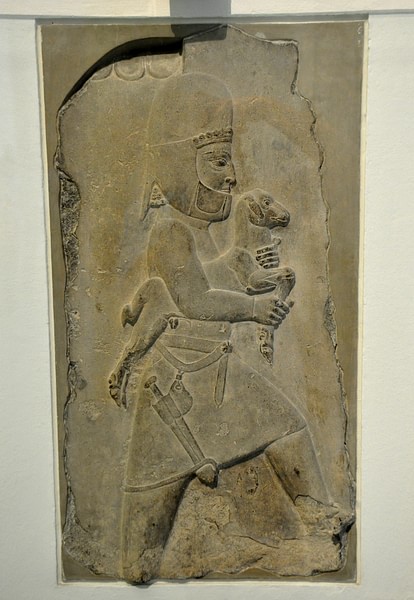
This attention to detail seems to have also characterized the gardens of the Achaemenids and, by extension, all of their art. This same can certainly be said of the artworks of other civilizations, and the Achaemenids freely drew on Greek, Median, and other elements in the creation of their own; but Achaemenid art and architecture is chiefly characterized by a single, almost overwhelming, effect of the whole being greater than any of the sum of its parts.
The Parthian Period
The Achaemenid Empire fell to Alexander the Great in 330 BCE and was replaced by the Seleucid Empire under Seleucus I Nicator (r. 305-281 BCE), one of Alexander's generals. The Seleucids maintained the earlier structures but, as Greeks, naturally pursued their own artistic vision and created in their own style. In 247 BCE, their empire fell to the Parthians, and Persian art and architecture resumed development. This is not to say no progress at all was made during the time of the Seleucids, but the kinds of innovation and detail of the earlier empire do not appear during this time.
The Parthians were a semi-nomadic people initially, and their art reflects the diverse regions they had come in contact with. Although they retained the basics of Achaemenid artworks, their vision was expressed in circularity in architecture and frontality in art. The bas-reliefs of the Achaemenids – featuring images of people from the side – were replaced by statuary and images which meet a viewer face-to-face. One excellent example of this is the frontal bas-relief of a Parthian king offering sacrifice to the god Heracles-Verethragna, patron god of royal dynasties, presently housed in room 310 of the Louvre Museum, Paris, France. The king holds a cornucopia in his left arm while his right offers a sacrifice at a Fire Altar. This image, like many, once adorned a temple dedicated to the god and the use of frontality would have brought a visitor into direct contact with the image of the king, offering one a chance of communion with a fellow supplicant from the past.
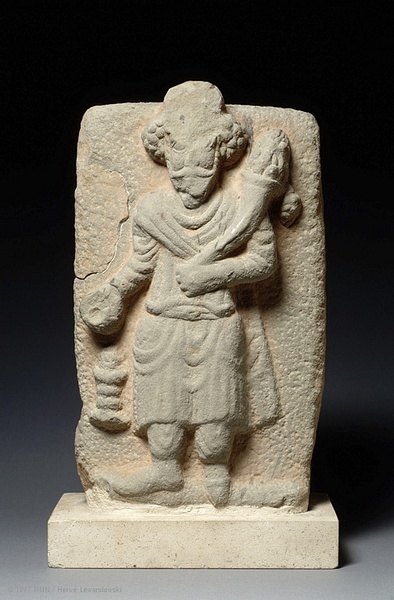
Scholar Homa Katouzian points out that Parthian art and architecture was influenced by “Achaemenid, Hellenistic, and Mesopotamian forms, tempered by their own nomadic traditions” but they drew on these influences to make the art uniquely their own (45). The use of the dome was already a staple of Roman art, for example, but the Parthians took this concept and expanded upon it. Roman domes were situated on the tops of structures; Parthian domes rose from the earth, accentuating height as well as strength and stability, drawing the eye upwards and directly back down to the ground. A visitor to their capital of Nisa could have continued the line of the dome, imaginatively, into the earth and back up to form a circle and the circle-motif featured in almost all Parthian works of art and architecture, symbolizing completeness.
Sassanian Art & Architecture
The Sassanian Empire continued these innovations and, like the others before them, learned from and drew upon multiple influences. The brilliance of the Sassanians was their ability to fully integrate what had worked in the past into their present efforts and improve upon it. Sassanian art is the pinnacle of Persian artistic endeavor in the same way that the Sassanian Empire as a whole exemplified the greatest aspects of ancient Persian culture. The art and architecture of this era epitomize the Persian values of balance and symmetry which would influence later works in the region and elsewhere.
The Sassanian Empire was founded by Ardashir I (r. 224-240 CE) who had been a general under the Parthians before he overthrew the last Parthian king and established his own dynasty. Ardashir I almost instantly initiated the building projects which remain the best examples of Sassanian art. Under Ardashir I – and developed further under his son and successor Shapur I (r. 240-270 CE) – the dome and minaret became staples in architectural design. The Parthian motif of frontality in bas-reliefs was abandoned in favor of the Achaemenid treatment of images in profile or three-quarter view.
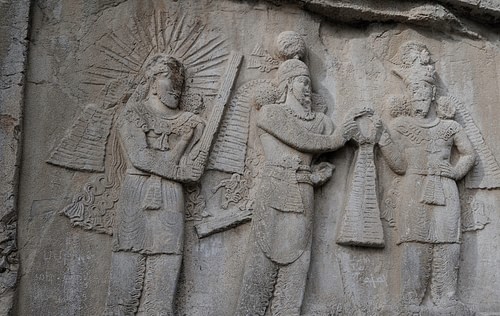
The Sassanians drew on both the Parthian and Roman dome and arch techniques to create arch-supported structures which still conveyed the concept of circularity. The best example of this is the famous palace at Ctesiphon known as Taq Kasra – probably built by Kosrau I (r. 531-579 CE) though sometimes attributed to Shapur I – which features the largest single-span vaulted arch of unreinforced brickwork in the world, unequaled anywhere even in the present day. The ruins, still extant, were the entryway to a grand imperial palace - as Ctesiphon was the Sassanian capital – which was built to mirror the grandeur of Achaemenid masterpieces like Persepolis.
Sassanian art kept the floral motifs of the Achaemenids and the circularity of the Parthians but enhanced their works with images of the hunt, dances, parties, and other pastimes as well as scenes of battle, religious motifs, and mythological tales. These figures are almost always depicted in profile although some – such as those on silver plates and drinking vessels – are frontal. The greatest and best-known example of frontal Sassanian art is the colossal statue of Shapur I which stands 21 feet (6.7 meters), carved from a single stalagmite in the Shapur Cave in Iran. Even in ruin, the statue still breathes life and its immense height clearly impresses upon a visitor the grandeur of its subject.
Conclusion
The rise of Islam in the 7th century CE and the subsequent conquest of various regions by Muslim Arabs led inevitably to the fall of the Sassanian Empire in 651 CE. The ancient Persian religion of Zoroastrianism was suppressed – as were many other aspects of Persian culture – in an effort to firmly establish an Islamic-Arabian worldview. Even so, Persian art and architecture endured and came to influence later Islamic-Arabian works. The minaret, almost synonymous with Islamic architecture in the present day, is – as noted – a Sassanian innovation. Homa Katouzian notes:
From the beginning of the Arab conquest, Iranians were involved in the new regime, whether as converted warriors, local administrators, scribes, or later as viziers, linguists, poets, literati, intellectuals, rebels, and eventually founders of new dynasties…The loss of the Sassanian Empire was not synonymous with the demise of the Iranians who, even in the first two centuries after the conquest and before the foundation of Persian dynasties, played a decisive role in the internationalization of Islamic society and culture. (67)
Persian art and architecture continues to exert a powerful influence in the present day as it honors the traditions of the past in taking what worked well before and improving upon it. Persian architects and artists today are keenly aware of their heritage – some artisans even continuing to work in metals as their ancestors did thousands of years ago – and draw on their history to preserve and honor the past. Persian ceramics, rugs, statuary, and textiles continue to be among the most popular in the world, an enduring legacy of one of the greatest of all the ancient civilizations.
